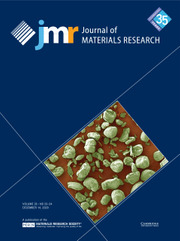Crossref Citations
This article has been cited by the following publications. This list is generated based on data provided by
Crossref.
Cohen, Sidney R.
Apter, Nathan
Jesse, Stephen
Kalinin, Sergei
Barlam, David
Peretz, Adi Idit
Ziskind, Daniel
and
Wagner, H. Daniel
2008.
AFM Investigation of Mechanical Properties of Dentin.
Israel Journal of Chemistry,
Vol. 48,
Issue. 2,
p.
65.
Jakes, Joseph E.
Frihart, Charles R.
and
Stone, Donald S.
2008.
Creep properties of micron-size domains in ethylene glycol modified wood across 4½ decades in strain rate.
MRS Proceedings,
Vol. 1132,
Issue. ,
Beecher, James F.
Hunt, Christopher G.
and
Zhu, J. Y.
2009.
The Nanoscience and Technology of Renewable Biomaterials.
p.
61.
Schöberl, T.
Jäger, I.L.
and
Lichtenegger, H.C.
2009.
Applied Scanning Probe Methods XIII.
p.
71.
Pathak, Siddhartha
Cambaz, Z. Goknur
Kalidindi, Surya R.
Swadener, J. Gregory
and
Gogotsi, Yury
2009.
Viscoelasticity and high buckling stress of dense carbon nanotube brushes.
Carbon,
Vol. 47,
Issue. 8,
p.
1969.
Jakes, J.E.
Frihart, C.R.
Beecher, J.F.
Moon, R.J.
Resto, P.J.
Melgarejo, Z.H.
Suárez, O.M.
Baumgart, H.
Elmustafa, A.A.
and
Stone, D.S.
2009.
Nanoindentation near the edge.
Journal of Materials Research,
Vol. 24,
Issue. 3,
p.
1016.
Konnerth, Johannes
Gierlinger, Notburga
Keckes, Jozef
and
Gindl, Wolfgang
2009.
Actual versus apparent within cell wall variability of nanoindentation results from wood cell walls related to cellulose microfibril angle.
Journal of Materials Science,
Vol. 44,
Issue. 16,
p.
4399.
Puthoff, J.B.
Jakes, J.E.
Cao, H.
and
Stone, D.S.
2009.
Investigation of thermally activated deformation in amorphous PMMA and Zr-Cu-Al bulk metallic glasses with broadband nanoindentation creep.
Journal of Materials Research,
Vol. 24,
Issue. 3,
p.
1279.
Zhao, Y.
and
Ovaert, T.C.
2010.
Error estimation of nanoindentation mechanical properties near a dissimilar interface via finite element analysis and analytical solution methods.
Journal of Materials Research,
Vol. 25,
Issue. 12,
p.
2308.
Zhang, Xinan
Zhao, Qiuhong
Wang, Siqun
Trejo, Rosa
Lara-Curzio, Edgar
and
Du, Guanben
2010.
Characterizing strength and fracture of wood cell wall through uniaxial micro-compression test.
Composites Part A: Applied Science and Manufacturing,
Vol. 41,
Issue. 5,
p.
632.
Schöberl, Thomas
L. Jäger, Ingomar
and
C. Lichtenegger, Helga
2010.
Biosystems - Investigated by Scanning Probe Microscopy.
p.
81.
Nair, Sandeep S.
Wang, Siqun
and
Hurley, Donna C.
2010.
Nanoscale characterization of natural fibers and their composites using contact-resonance force microscopy.
Composites Part A: Applied Science and Manufacturing,
Vol. 41,
Issue. 5,
p.
624.
Stöckel, Frank
Konnerth, Johannes
Kantner, Wolfgang
Moser, Johann
and
Gindl, Wolfgang
2010.
Tensile shear strength of UF- and MUF-bonded veneer related to data of adhesives and cell walls measured by nanoindentation.
Holzforschung,
Vol. 64,
Issue. 3,
Stone, Don S.
Jakes, Joseph E.
Puthoff, Jonathan
and
Elmustafa, Abdelmageed A.
2010.
Analysis of indentation creep.
Journal of Materials Research,
Vol. 25,
Issue. 4,
p.
611.
Marathe, G.
and
Hebert, R. J.
2010.
Hardness measurements of accumulative roll-bonded Mo foils.
Journal of Materials Science,
Vol. 45,
Issue. 17,
p.
4770.
Sicre-Artalejo, José
Campos, Mónica
Molina-Aldareguía, Jon M.
and
Torralba, José M.
2011.
Quantification of hardening in Fe–Mn master alloys prepared by a mechanical alloying process via nanoindentation experiments.
Journal of Materials Research,
Vol. 26,
Issue. 14,
p.
1726.
Clauß, Sebastian
Gabriel, Joseph
Karbach, Alexander
Matner, Mathias
and
Niemz, Peter
2011.
Influence of the adhesive formulation on the mechanical properties and bonding performance of polyurethane prepolymers.
hfsg,
Vol. 65,
Issue. 6,
p.
835.
Vivanco, Juan
Slane, Josh
Nay, Rick
Simpson, Amanda
and
Ploeg, Heidi-Lynn
2011.
The effect of sintering temperature on the microstructure and mechanical properties of a bioceramic bone scaffold.
Journal of the Mechanical Behavior of Biomedical Materials,
Vol. 4,
Issue. 8,
p.
2150.
Jakes, Joseph E.
and
Stone, Donald S.
2011.
The edge effect in nanoindentation.
Philosophical Magazine,
Vol. 91,
Issue. 7-9,
p.
1387.
McAllister, Quinn P.
Gillespie, John W.
and
VanLandingham, Mark R.
2012.
Evaluation of the three-dimensional properties of Kevlar across length scales.
Journal of Materials Research,
Vol. 27,
Issue. 14,
p.
1824.

